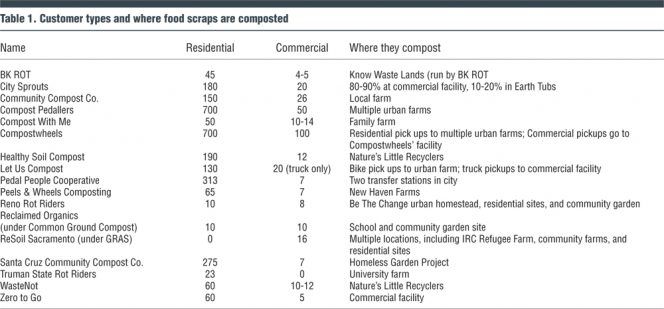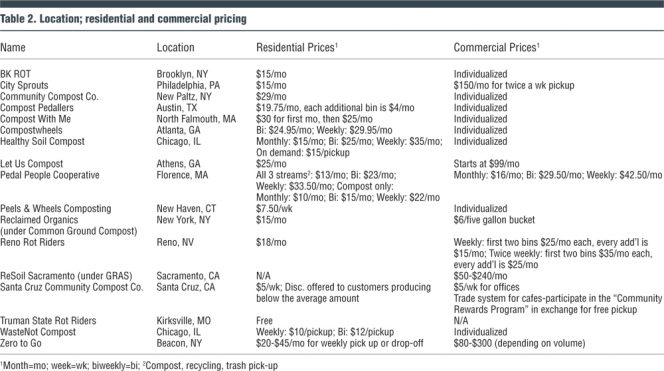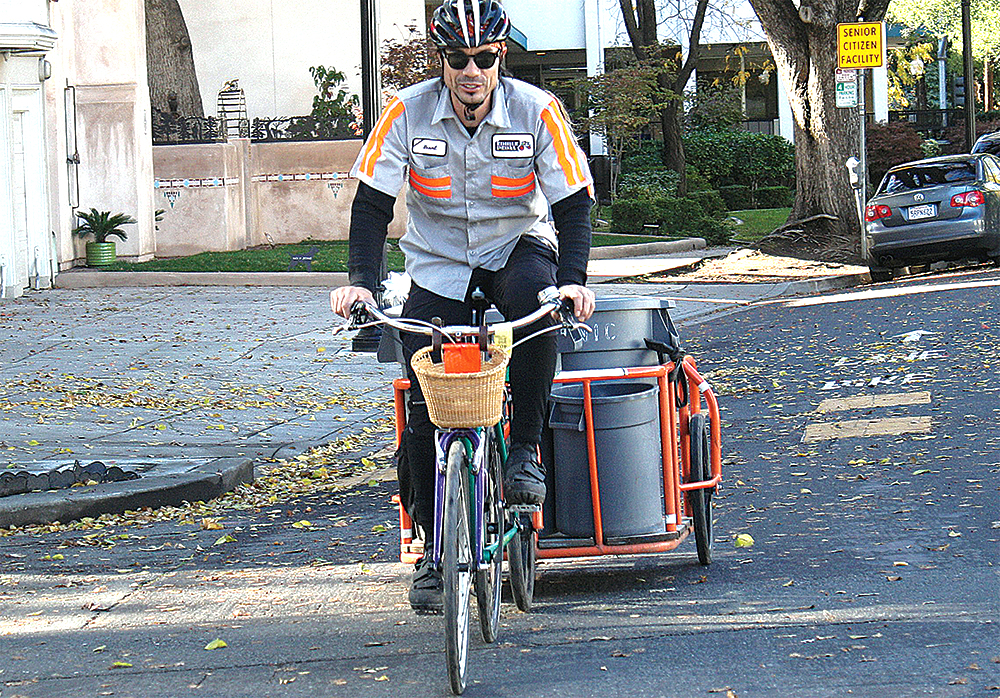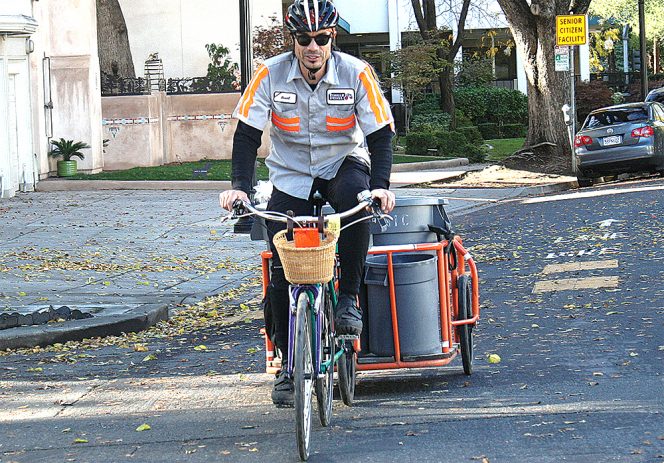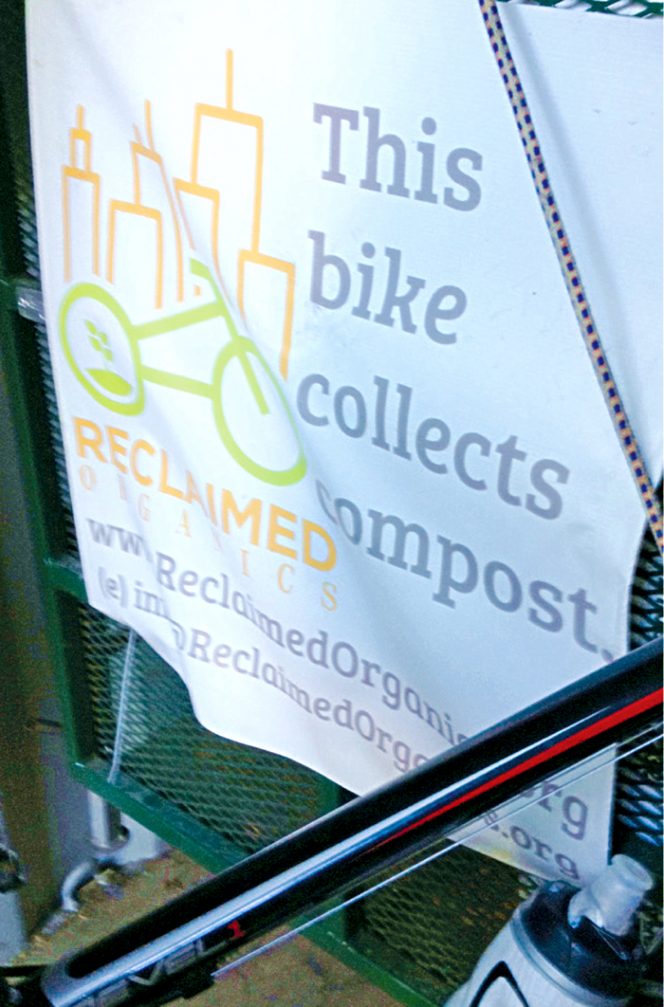Services utilizing bikes pulling trailers are starting up all over the U.S. Entrepreneurs share lessons learned.
Virginia Streeter and Brenda Platt
BioCycle January 2017
Food scrap collection services have been starting up all over the country, providing an opportunity for residential and commercial customers to divert organics. One segment of this burgeoning sector is bike-powered collection. The Institute for Local Self-Reliance (ILSR) recently interviewed 17 bike-powered food scrap collectors and visited the sites of three. This article summarizes information gleaned from these organizations, and includes their tips for running a food scrap collection service. Tables 1 and 2 provide specific details on each collection service. The ILSR undertook this research to facilitate replication of a bike-powered food scrap collection and community composting program with the Chesapeake Center for Youth Development in the Curtis Bay neighborhood of Baltimore.
Questions asked during the interviews covered starting up, employees and volunteers, composting sites and processes, equipment, customer engagement and marketing, and finances. The majority of interviewees have a residential and commercial customer base. Truman State Rot Riders, a student organization, is one exception — it exclusively serves residential customers. ReSoil Sacramento, one of the programs run by GRAS (Green Restaurant Alliance Sacramento), only serves restaurants and other food providers (e.g. a zoo and a women’s shelter) as GRAS’ mission is to create a more sustainable food community by working directly with providers. Kristen Baskin of Let Us Compost only offers bike pickup services to residential customers, and uses a truck for commercial customers.
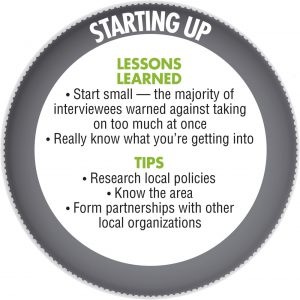 Starting Up
Starting Up
While each company’s start-up is unique, some experiences were nearly universal. Almost everyone was inspired by the example of an already existing company, and thus took that as a model. However, even when following these examples, many interviewees talked about missteps they had made. For instance, almost everyone warned against taking on too much at the beginning. Ivy Young at Santa Cruz Compost Co. says she found it difficult to say no to anyone interested in her services, and thus has found herself stretched a little too thin in the area she is covering. Several organizations suggested really trying to focus on one neighborhood at a time. It is also helpful if this neighborhood is fairly dense, especially for biking services, because otherwise the distances between pick ups can become too much to handle for bikers.
Many interviewees also talked about the difficulty of this job, and forewarn anyone starting out to be prepared to put in a lot of time and effort, frequently with little reward at the beginning. Kyle Chandler-Isacksen of Reno Rot Riders said that starting out was so difficult that he really regretted not having a partner, or at least a backup to cover routes. Others greatly benefitted from having close partnerships from the very beginning. For example, Domingo Medina started Peels & Wheels under the umbrella of New Haven Farms, an already existing nonprofit organization, and is just now branching off into his own company. When starting out, he was able to utilize New Haven Farms’ existing contacts, and have a guaranteed location to compost.
Another critical start up component is being very familiar with your area, such as knowing which neighborhoods are likeliest to be successful, or talking to local environmental and health departments to ensure all regulations and policies are being followed. For those planning to serve commercial customers, knowing the local trash collection and tipping fees is vital. For instance, Community Compost Co. struggled when expanding to Hoboken, New Jersey, because the founders were unaware of the city policy that businesses in the city do not have to pay any trash collection fees. Therefore, paying for a food scrap collection service is an extra expense that the majority of businesses are not willing to take on.
Finally, the business side of the operation cannot be neglected. Liam Donnelly, founder of Waste
Not Compost, has some important words of advice: Get references for accountants at the beginning to make things a little easier come tax season, and have a plan for growth. Donnelly in particular ran into issues of what to do with his food scraps when his business grew faster than anticipated. Having a plan for this best-case scenario can really help avoid problems down the road.
Employees And Volunteers
Generally, the type of people attracted to a job like this are already dedicated bikers. The job requires physical fitness, as well as willingness to be out in less than ideal weather conditions, and have somewhat irregular hours, therefore employees really have to be bought into the idea. ReSoil Sacramento and Truman State Rot Riders are the only organizations interviewed relying heavily on volunteers. Rot Riders is a student organization, and they do not charge for their services, so the workforce is 100 percent volunteer. ReSoil Sacramento has two paid employees, but uses volunteers for both collection and composting.
BK ROT has a unique attitude towards employees. Its focus is on employing youth of color; young adults are in charge of the hauling and composting, with two adult “facilitators” managing the overall project and compost distribution. Thus, in addition to promoting sustainability by providing composting services to the community, BK ROT is catalyzing social change by creating jobs in the environmental sector for young adults who normally would not have access to this field.
Similarly, Compostwheels places a premium on youth involvement. It runs a summer youth corps program that pairs young adults with current employees in order to learn about the business. Participants come from disenfranchised communities, such as the homeless population.
Composting Sites And Processes
The organizations interviewed were divided on their involvement in the actual composting process. Community gardens and urban farms are the most popular sites for processing the food scraps collected (Table 1). There are some notable locations, such as ReSoil Sacramento’s work with the International Rescue Committee’s Refugee Farm, and Santa Cruz Compost Co.’s focus on the Homeless Garden Project, which serves as the host composting site. Workers at the Refugee Farm are doing the composting themselves, whereas Young of Santa Cruz Compost is also involved in the composting. Mary Ryther of Compost With Me and Kaitlyn Meyer of Truman State Rot Riders are also very engaged in both pickup and composting. All food waste collected by Compost With Me is processed at Ryther’s farm. At Truman State, the Rot Riders collect food scraps, which the Garden Club composts an organic farm on campus.
Other organizations, such as Compost Pedallers and Pedal People Cooperative, are solely focused on hauling food scraps, and not engaged with the composting process at all. Of the haulers, most drop off at urban farms, as noted. In a few cases, the food scraps go to a large, industrial-sized facility, which generally involves some cost to the collection service. Healthy Soil Compost and WasteNot Compost, both based in Chicago, send collected food scraps to Nature’s Little Recyclers Farm, a worm farm in the region that charges a tipping fee of $0.10 per pound. Zero to Go uses a separate hauler, Empire Zero, which charges a fee to transport food waste to the regional composting facility. City Sprouts and Let Us Compost both divide what is collected between industrial-sized and smaller sites. City Sprouts sends the majority of its collected waste to a commercial facility, while 10 to 20 percent goes into Earth Tubs at its local urban site. Let Us Compost takes waste collected from its commercial clients to a large facility and processes the waste from its residential collection on an urban farm.
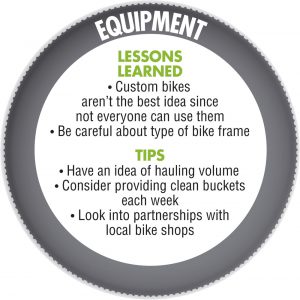 Aerated static piles are the most popular method of composting; aerated windrow composting is second. The majority of organizations processing food scraps at small community sites are using hot piles. However, for organizations that are solely hauling, the interviewees did not necessarily know what kind of process the composting sites are using — especially with organizations like Compost Pedallers, where the food collected is going to multiple sites. Reclaimed Organics, which is operated under Common Ground Compost, is the only bike-powered collector interviewed to use the bokashi fermentation method, and ReSoil Sacramento uses sheet mulching. Although these are unique systems, they work well for those organizations. No definitive recommendations for composting came out of the interviews; each organization has found a system that works best for their capacity, client base, and area.
Aerated static piles are the most popular method of composting; aerated windrow composting is second. The majority of organizations processing food scraps at small community sites are using hot piles. However, for organizations that are solely hauling, the interviewees did not necessarily know what kind of process the composting sites are using — especially with organizations like Compost Pedallers, where the food collected is going to multiple sites. Reclaimed Organics, which is operated under Common Ground Compost, is the only bike-powered collector interviewed to use the bokashi fermentation method, and ReSoil Sacramento uses sheet mulching. Although these are unique systems, they work well for those organizations. No definitive recommendations for composting came out of the interviews; each organization has found a system that works best for their capacity, client base, and area.
Depending on the service, some of the compost goes back to customers. Frequently, much of the compost remains at the host sites where the food scraps are processed. In some cases, this is a requirement; for example, due to a Massachusetts state regulation, 50 percent of the compost produced by Compost With Me at its farm has to stay on-site. And finally, some organizations sell their compost; Compost With Me does this with compost not used on its farm.
Equipment
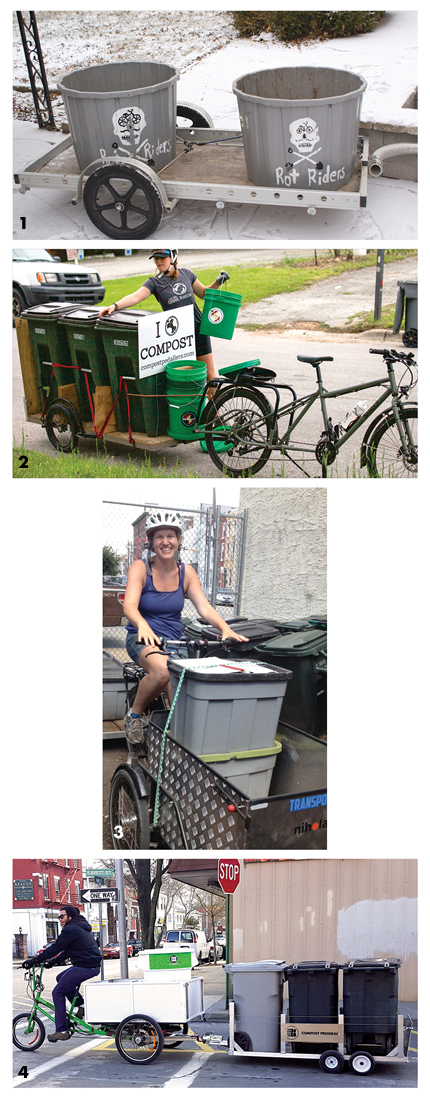
Figure 1. Truman State Rot Riders’ Bikes at Work trailer
Figure 2. Compost Pedallers’ Kanner Kart
Figure 3. City Sprouts’ custom trike
Figure 4. Zero to Go’s Cycles Maximus tricycle
Trailers
Of those interviewed, there are some definite patterns in the equipment used. Bikes at Work (Figure 1) is one of the more popular trailer brands, with rave reviews from all those who use one. Bikes at Work trailers range in price from $650 to $1,150. Another popular trailer option is Kanner Carts (Figure 2). The founder of Gainesville Compost, another bike-powered food scraps collection service, also started Kanner Carts, so the trailer was designed for that purpose. Two options are available: the Commuter Bicycle Trailer ($299), which holds 200 lbs., and a custom trailer, which starts at $1,399.
There are a few less common trailer brands that still received good reviews from their users: the Aosom cargo trailer used by BK ROT and Let Us Compost, which only costs $100, and Surly trailers, used by WasteNot Compost. A few companies built their own trailers, but purchasing a trailer is overall the easier and more popular decision.
Tricycles are another option. City Sprouts uses a tricycle with electric assist that was custom-made in Denmark (Figure 3); it was an $8,000 investment. The tricycle has advantages, notes Jennifer Mastalerz of City Sprouts: It is stable, can be used by riders with any level of experience, and does not have to be sized for the rider. Zero to Go uses a tricycle, made by Cycles Maximus, with a Lynch drive electric assist motor that can handle up to 1,000 lbs when paired with its custom trailer (Figure 4).
Bikes
The majority of organizations interviewed had an expectation that collectors would provide their own bikes, so they did not have much advice to offer on bike selection. A few, such as Truman State Rot Riders, have an organization bike. Some formed partnerships with local bike shops, providing free collection service in exchange for a free or significantly reduced cost bike. Meyer of Truman State Rot Riders warns that it had an aluminum bike break under the stress of a full load, and recommends looking for bikes with steel frames. Donnelly of WasteNot did not necessarily believe that any particular brand was the best, but recommends any well-made bike with a high gear ratio, as that makes bikes easier to use when pulling a lot of weight. He also suggests seriously considering electric assist bikes, if in the budget. Chandler-Isacksen of Reno Rot Riders uses a “standard” mountain bike with road tires. Santa Cruz Community Compost Co. and Compostwheels both use cargo bikes. A local bike shop made Santa Cruz Compost’s bike, and while it works well, Young says other collectors have trouble using it because it was custom-made specifically for her. Compostwheels uses a Madsen electric assist bike, which has worked very well.
Inclement weather is always going to be an issue for a company relying on biking as its primary mode of transportation. For some organizations, such as Compost With Me, being prepared for weather means having a backup truck to use when biking proves impossible. City Sprouts has rented Zipcars on occasion when unable to bike, and Compost Pedallers has a tradition of buying outdoor gear for its bikers every year for Christmas.
Buckets
One other vital piece of equipment is the collection bucket. Some interviewees recommend a few sources for buckets, including Home Depot, Affordable Buckets, and restaurants, which sometimes have five gallon buckets that they are willing to give away for free. A few organizations do not provide clean buckets every week, either because they decided the cost was too much, or, as in the case of Peels & Wheels, felt that customers should be responsible for that task. However, the majority of services provide clean buckets each week, as they worry the “grossness” of food waste deters potential customers.
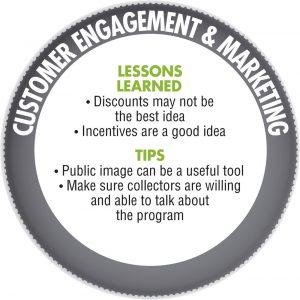 Customer Engagement And Marketing
Customer Engagement And Marketing
Finding Customers
Almost every collection service interviewed used local farmers’ markets as a starting point to find customers, usually by handing out fliers. Healthy Soil Compost utilized online community forums to find customers, and Pedal People Cooperative mails fliers to all new homeowners in its service area. However, as their organizations grew, they relied more on word-of-mouth.
Retaining Customers
Good communication is key to keeping customers and making sure they remain happy with the service. One interviewee explained that creating clear policies and following through on them has been vital to his business. His customers need to give advance notice if they are missing a pick up day; if notice is not received, the customer will be charged for the pick up. This policy is stated clearly when signing up for service. WasteNot Compost emphasizes the importance of having policies in writing, especially for commercial customers.
Almost all interviewees have some kind of compost “giveback” program, where customers can receive a share of the final product for free. Usually, customers can receive compost three to four times a year; limits are set on the quantity, however, no interviewee said that the majority of customers request compost.
Marketing Strategies
While distributing fliers at farmers’ markets was a popular strategy when starting out, most interviewed now say it is no longer necessary as their recognition in the community is such that the majority of customers are coming to them via word of mouth. Additionally, many interviewees talked about the added marketing value of using bikes for pick ups. People in the community see the bikes with their attached trailers and show interest in what the collectors are doing. Many organizations have the company name and logo on their trailers to spread the word (Figure 5).
Websites also help. Santa Cruz Compost’s URL, https://santacruzcompost.com, ensures that it is one of the first search results that appears when people search for compost in Santa Cruz. For the websites themselves, it is valuable to have a map that clearly shows service areas, as well as information on pricing, what can and cannot be composted, and contact information. The best websites also include graphics explaining the composting process.
Financing
Start-Up and Ongoing Costs
Although very important, attention to financing varied among interviewees — both in terms of knowledge and preparation. Many did not keep records of initial start-up costs, and did not have current operating costs on hand. Those with an exact number for current operating costs emphasized there is very little overhead. Once a company has purchased bikes, trailers, and collection buckets, the only ongoing costs are salary and, in some cases, insurance.
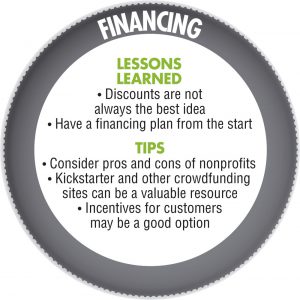 Insurance is one of the largest costs for many. Few have insurance on their equipment, but many have some sort of liability and workers’ compensation insurance. As biking on city streets with heavy trailers poses some risk, organizations with these insurances really recommend making it a priority. However, insurance comes at a high price: Compost With Me pays $1,500/year for workers’ compensation insurance and $1,000/year for liability insurance.
Insurance is one of the largest costs for many. Few have insurance on their equipment, but many have some sort of liability and workers’ compensation insurance. As biking on city streets with heavy trailers poses some risk, organizations with these insurances really recommend making it a priority. However, insurance comes at a high price: Compost With Me pays $1,500/year for workers’ compensation insurance and $1,000/year for liability insurance.
Pricing
Most residential services fall somewhere between $20 and $35/month for weekly collection (Table 2). Some offer a scale of pricing depending on collection frequency, however, different pick up frequencies can complicate route design. For commercial clients, pricing structures vary based on service needs. A few have set prices for commercial accounts. Customers served by the interviewees include schools, restaurants, cafes, zoos, churches, and offices. Although prices of the vehicle collection services are not discussed in this article, most of those organizations interviewed have a fairly robust commercial clientele, and they definitely favor individualized pricing plans.
Discounts And Incentives
Few companies offer discounts on their services. Santa Cruz Community Compost Co. offers a discount based on the quantity of food scraps that customers are producing. Anyone producing below the average amount of all collected food scraps gets an equivalent discount; so a customer producing 20 percent below the average amount (in pounds) gets a 20 percent discount. Although this does incentivize customers to produce less food scraps, the owner of Santa Cruz Compost says she somewhat regrets this discount, as customers producing below the average are still receiving the exact same service as everyone else. However, as of now, the company is keeping this policy in place, as it is popular with customers.
The Pedal People Cooperative also offers discounts to customers — 15 percent off for households where all occupants are over the age of 62 or disabled. Healthy Soil Compost offers discounts for customers paying for several months at a time — five percent off for a 6-month membership and 10 percent off for a 12-month membership.
Peels & Wheels gives a $1 discount per referral, and Compost Pedallers offers a free month to both referrer and referee. Additionally, several services offer incentives to current customers who participate for a certain amount of time, or provide a certain amount of food waste. Compost Pedallers is one example of this type of program: Customers receive one point for each pound of food waste they divert from the landfill. They can then redeem their points at participating local businesses. A cup of coffee at a local coffee shop “costs” eight points, and a week of free yoga classes “costs” 135 points. Typically, businesses participate in these programs in exchange for free or reduced collection service. This strategy is attractive to customers, and also helps build partnerships in the local community. Santa Cruz Compost also has a similar system.
Ongoing Financing Strategies
There was an array of financing strategies among interviewees, especially between the nonprofits and the for-profit companies. Nonprofits have access to sources of funding that for-profits do not, such as grants and donations. Patagonia was frequently mentioned as a source of grants. However, the for-profit companies had their reasons for choosing that business structure. Some were simply unaware of the advantages and disadvantages of nonprofits, and saw starting a for-profit as the natural first step. Others, such as Community Compost Co., considered each option, but wanted to prove food scrap collection as a business model.
Very few interviewees took out loans to finance their businesses. For many, this was due to the difficulty involved in starting a business that many banks simply did not understand. Some companies were successful finding investors who helped them grow. Other companies turned to more creative strategies, such as crowdfunding. Peels & Wheels is planning on starting a Kickstarter campaign in order to fund a larger composting site.
In conclusion, these interviews illustrate many best practices for bike-powered pick up. Each entity is unique, because the communities they are serving are unique. However, one thing connecting all of these companies is the commitment of their workers. As David Paull of Compostwheels said, in order to be successful, “you need sheer passion and love for the initiative.”
Virginia Streeter is an intern with the Institute for Local Self-Reliance (ILSR). She graduated from The George Washington University in May 2016 with a B.A. in Environmental Studies. Brenda Platt heads up ILSR’s Composting for Community Project and is the lead author on Growing Local Fertility: A Guide to Community Composting.
